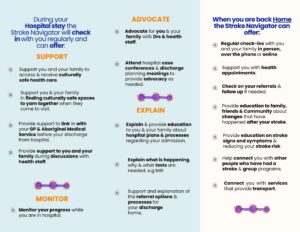YuAS Stroke Navigator
The Stroke Navigator role was developed by First Nations Peoples living with stroke, their families and carers, and health service providers living on Gamilaraay/Gomeroi lands in the Hunter New England Local Health District and the Yarning up After Stroke project team. This research project is led by the Hunter New England Local Health District and funded by a Medical Research Future Fund Grant.
An important part of this research project is to trial the role for 6 months, and understand how helpful this role is.
All stroke survivors receiving support from the Yarning up After Stroke Navigator role need to meet the below criteria:
- Be Aboriginal and/or Torres Strait Islander
- Be 18 years old or older
- Have had a stroke within the past 6 months
- Be living on Gamilaraay/Gomeroi lands within the Hunter New England Local Health District
- Agree (consent) to be involved in the Yarning up After Stroke Research Project which involves meeting with an Aboriginal researcher two times over 3 months, to yarn about your mood, health and well-being (to complete 2 surveys).
Contact the Yarning up After Stroke Team
on 0487 133 102.


Important Documentation
Human Research Ethics Details
Hunter New England Human Research Ethics Committee:
Hunter New England Human Research Ethics Committee 2020/ETH02782
Aboriginal Health & Medical Research Council Ethics Committee: The Chairperson, Aboriginal Health & Medical Research Council Ethics Committee, 35 Harvey Street, Little Bay, NSW, 2012, ethics@ahmrc.org.au .

